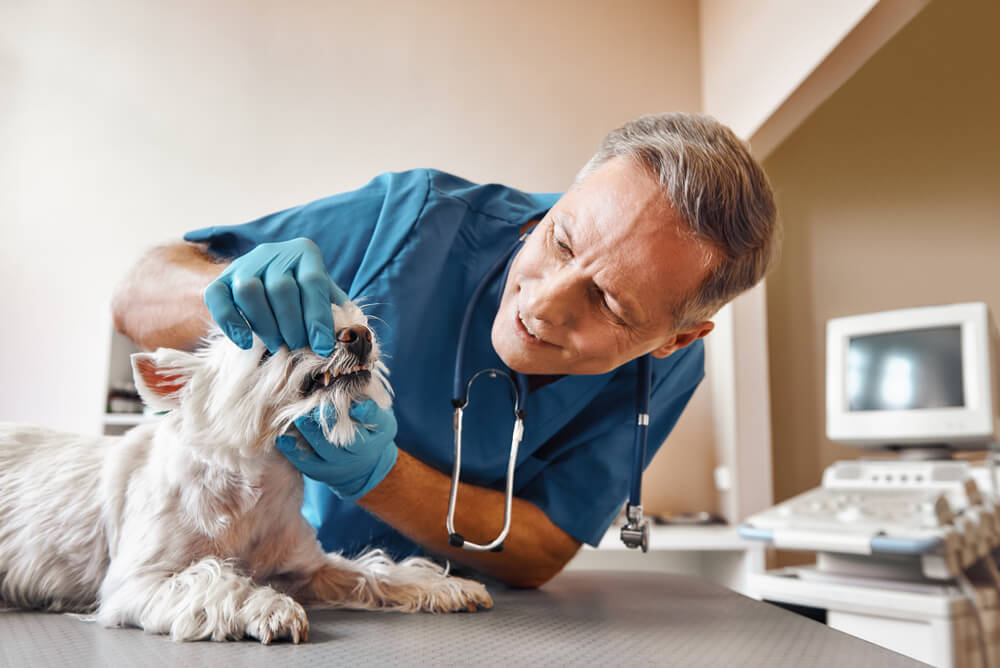
Pet stores and grooming facilities commonly offer non-anesthetic dentistry (NAD) to remove tartar from your pet’s teeth while they are awake. This may sound like a good option for keeping your pet’s teeth clean and healthy, but NAD is not considered appropriate for pets. Our Livermore Family Pet Hospital team is well-trained in the most modern veterinary dental techniques, and we explain why NAD is contraindicated in pets, and how you should promote your pet’s oral health.
#1: Your pet’s mouth can’t be thoroughly assessed
According to the American Veterinary Dental Society, 80% of dogs and 70% of cats have some degree of dental disease before they are 3 years of age. However, periodontal disease cannot be determined by a simple visual inspection. When our team performs a professional dental cleaning with your pet under general anesthesia, we not only observe your pet’s teeth and oral tissues, but also probe around each tooth, palpate oral structures, and perform dental X-rays. Without this thorough examination, serious issues can be missed. These issues include:
- Dead teeth — About 60% of the tooth is below the gum line, and dead teeth can appear normal on a visual inspection. X-rays are necessary to evaluate the tooth root and determine if the tooth is healthy.
- Bone degeneration — When periodontal bacteria invade below the gum line, the pathogens can damage bony structures. X-rays are necessary to see these changes.
- Fractures — Severe bone degeneration can lead to jaw fractures.
- Oro-nasal fistula — If periodontal bacteria migrate through the soft palate, an oro-nasal fistula can provide communication between the mouth and the nasal cavity. This abnormality can’t be detected when examining an awake pet’s mouth.
- Resorptive lesions — Resorptive lesions, which are painful erosions that commonly affect cats, cannot be detected without X-rays.
#2: Your pet’s mouth can’t be thoroughly cleaned
During NAD, tartar is removed from the visible surfaces of your pet’s teeth, but bacteria under the gum line are not addressed. This can lead to issues that include:
- Bad breath — Oral bacteria feed on protein in your pet’s mouth and release volatile sulfur compounds that smell bad.
- Painful gums — Infection and inflammation below the gum line cause swollen, painful gums.
- Loose and missing teeth — As the bacterial infection progresses, tooth roots deteriorate, leading to loose and missing teeth.
- Tooth root abscesses — The bacteria can also infect the tooth root, leading to painful abscesses that can rupture out your pet’s face or jaw, leaving a draining hole.
- Organ damage — Periodontal bacteria can enter the bloodstream, damaging organs such as the heart, kidneys, and liver.
#3: Your pet’s dental disease can’t be addressed
Individuals performing NAD are not equipped to address your pet’s complications, such as loose teeth, tooth root abscesses, and resorptive lesions. Dental procedures, including tooth extractions, can be performed only by a trained, licensed veterinarian.
#4: Your pet’s health is at risk
Dental procedures without the benefit of anesthesia put your pet at risk, because of:
- Injury — Sharp instruments are used to scale the tartar from your pet’s teeth, and their face and mouth can be injured if the pet does not stay still.
- Airway vulnerability — While under anesthesia, we use an endotracheal tube to protect your pet’s airway from removed tartar and water used to rinse your pet’s mouth. When your pet is awake, they can aspirate this material, potentially leading to aspiration pneumonia.
- Pain — Tartar removal can be painful, and NAD does not provide pain relief during the procedure.
#5: Your pet may experience significant stress
Pets can experience extreme stress when strangers are handling their mouth while yielding sharp instruments. Anesthesia allows our team to perform a thorough oral assessment and cleaning without the need for prolonged restraint, which prevents unnecessary stress for your pet.
#6: Your pet’s medical record is left incomplete
During a professional veterinary dental cleaning, our team carefully charts our findings in your pet’s medical record. This information is necessary to keep a complete picture about your pet’s overall health.
Steps to promote your pet’s oral health

While NAD is contraindicated, steps you can take to promote your pet’s oral health include:
- Scheduling regular wellness exams — Scheduling regular wellness exams is important to detect conditions, including periodontal disease, in the early stages, when they are easier to treat.
- Scheduling regular professional veterinary dental cleanings — Most pets need a professional veterinary dental cleaning about once a year, but small-breed dogs, brachycephalic pets, and those with dental abnormalities may require more frequent cleanings. Our team will determine how frequently we need to evaluate your pet’s mouth.
- Brushing your pet’s teeth — Plaque forms quickly on your pet’s teeth after a professional cleaning, and daily toothbrushing is the best way to keep their mouth clean and healthy. Ensure you use pet-friendly toothpaste since human dental products can be toxic to pets.
- Providing dental treats — Chewing can help remove plaque and tartar from your pet’s mouth. Choose only products approved by the Veterinary Oral Health Council (VOHC) that are proven effective.
NAD is strictly a cosmetic procedure that doesn’t address your pet’s oral health. Contact our American Animal Hospital Association (AAHA)-the accredited team at Livermore Family Pet Hospital to schedule your pet’s professional veterinary dental cleaning. We will ensure their mouth is clean and healthy.

